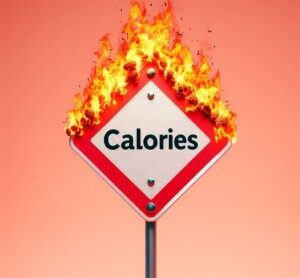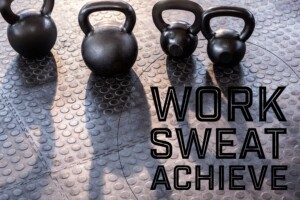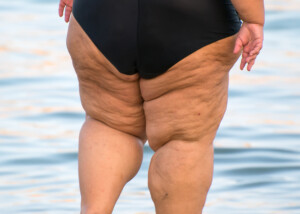
Wondering if lifting weights will make you bigger especially if you’re morbidly obese?
Confused because you’ve also heard you’ll get smaller from picking up weights?
Morbid obesity is when your BMI is over 40 — or, to put another way, more than 100 pounds over one’s ideal weight for their height, age and gender.
Many morbidly and moderately obese women believe that lifting more than light weights will bulk them up.
Muscles vs. Fat
Weightlifting or strength training mainly targets muscles.
It’s not like lifting weights will magically turn your fat into muscle or make you blow up like a balloon.
Barbells, dumbbells and weight machines, no matter how heavy the resistance, will not make fat cells bigger, either. Nor will they give you more fat cells.
Muscle and fat are different entities, completely different tissue.
- Fat doesn’t grow in size from lifting weights.
- It grows in size from lifting cupcakes to your mouth.
Think of muscle and fat as neighbors who live next to each other but don’t swap apartments.
Metabolic Magic
Here’s the cool part – lifting weights can actually rev up your metabolism. This even includes while you sleep.

©Lorra Garrick
It’s like giving your body a little boost to burn calories, not just during your workout, but even after you’ve hit the gym.
So, it’s more like a friendly metabolism party, not a size-increasing bonanza.
The caveat is that in order to achieve this “afterburn,” your workout must be intense. INTENSE.
Body Recomposition
Ever heard of body recomposition? This refers to the amount of muscle (lean mass) in your body increasing, while the size of your fat cells shrinks.
The net result is a smaller body, and a firmer looking one, not a bigger body.
So if you’re a size 28 when you first begin intensely strength training, you’ll need a whole new wardrobe — and much smaller — after several months, assuming that your food intake consists of controlled portions.
If you’re still wondering about female bodybuilders you’ve seen posing on stage, remember: If the competition is “professional,” this means that there’s no testing for anabolic steroids.
Many of these competitors use performance enhancing drugs.
But if you think that “natural” bodybuilders are still too muscular for your liking, I urge you to realize that they train for competition, not to lose 100 pounds of fat.
They train for long sessions, most days of the week, and as a contest date approaches, they go on a “cutting” diet which reduces their bodyfat levels so low that every detail of their musculature becomes visible.
This plan is not necessary for a morbidly obese woman to lose a significant amount of fat.
Cardio
Now, cardio is usually the go-to for weight loss, but working out with weights can also be a heart pumping affair.
It gets the heart working harder in a healthy way, contributing to a healthier cardiovascular system.
So, it’s not just about shedding pounds; it’s about being heart smart too.
However, strength training is not a replacement for aerobic exercise, whether for weight loss or better health.
Ideally, a morbidly obese person should do both cardio and weight training.
Personalize Your Workout

Don’t start out heavy if you’re new to weights. For example, an obese person will get plenty of a workout just with bodyweight squats at first. Once these are no longer difficult, you can start adding weights. Freepik.com
The common denominator among all morbidly obese women, and men, who want to lose weight, is that of intense compound strength training.
So, you don’t have to bench press to achieve your fat loss goals if you don’t like the bench press.
However, you still should do some form of chest training, such as the dumbbell press while lying flat on your back, or at least, lying at a 30 degree angle.
You can also do seated chest presses on machines.
You don’t have to put a barbell across your back to do squats if that doesn’t appeal to you.
You can do squats holding dumbbells or kettlebells at your shoulders, or holding a weight with straight arms between your legs.

Freepik/creativeart
The bottom line is to make sure you do big, multi-joint exercises — and intensely, as heavy as you can with safe form for eight to 12 reps.
Still Skeptical?
Next time you’re at the gym, take a look at the women who are lifting the heaviest.
How many are obese, especially morbidly?
The strongest women at a standard, conventional gym or health club are rarely obese.
Now, this isn’t to say that women with significant overweight can’t become impressively strong. They sure can.
But I can’t say it enough: Stop wondering if working out hard with resistance will make your big size even bigger. Won’t happen.
If you go to a powerlifting gym, you may see numerous obese women handling heavy barbells.
Don’t let this fool you. They didn’t get fat from lifting heavy weights.
Instead, many were attracted to the sport of powerlifting because it doesn’t discriminate against fat bodies.
But back to YOU: If you want to get smaller, shrink your big thighs, reduce your girth, lose fat, firm up and be so much healthier and fitter, you need to start hitting the heavy weights such as with the deadlift exercise — combined with making sure you’re not ingesting more calories than your body needs.
 Lorra Garrick is a former personal trainer certified by the American Council on Exercise. At Bally Total Fitness, where she was also a group fitness instructor, she trained clients of all ages for fat loss, muscle building, fitness and improved health.
Lorra Garrick is a former personal trainer certified by the American Council on Exercise. At Bally Total Fitness, where she was also a group fitness instructor, she trained clients of all ages for fat loss, muscle building, fitness and improved health.
.

























